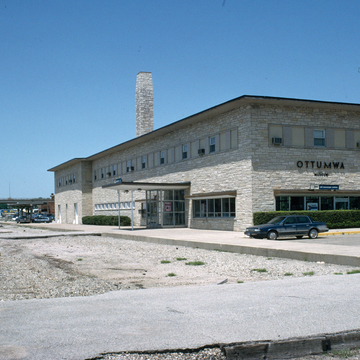The Chicago firm of Burnham and Root designed a number of small to large passenger stations in Missouri, Kansas, Illinois, and Iowa. In Iowa their major stations were the ones at Des Moines, Keokuk, and Burlington, and the other one was at Ottumwa. It is almost impossible to conceive that under this post-World War II modernist shell are parts of Burnham and Root's Romanesque Revival building. A tall chimney now soars into the sky, replacing their open tower, and a flat roof now exists as a replacement for their gabled and dormered tile roof. The station as it now exists conveys a mild modernist image, similar to but in certain ways more conservative than the station at Burlington. Like that station, this one is sheathed in light-colored limestone, and the windows and the intervening wall surfaces are treated as horizontal bands. A thin cantilevered roof tops the building, and the principal glassed entrance to the building also has its own thin slab roof. This building, which houses the usual station functions as well as the divisional offices of the Chicago, Burlington, and Quincy Railroad, was one of the last stations to be built in Iowa.
You are here
Ottumwa Union Depot, Chicago, Burlington, and Quincy Railroad
1887–1889, Burnham and Root. 1951, Holabird and Root, and Burgee. Main St., south end of Washington St.
If SAH Archipedia has been useful to you, please consider supporting it.
SAH Archipedia tells the story of the United States through its buildings, landscapes, and cities. This freely available resource empowers the public with authoritative knowledge that deepens their understanding and appreciation of the built environment. But the Society of Architectural Historians, which created SAH Archipedia with University of Virginia Press, needs your support to maintain the high-caliber research, writing, photography, cartography, editing, design, and programming that make SAH Archipedia a trusted online resource available to all who value the history of place, heritage tourism, and learning.














